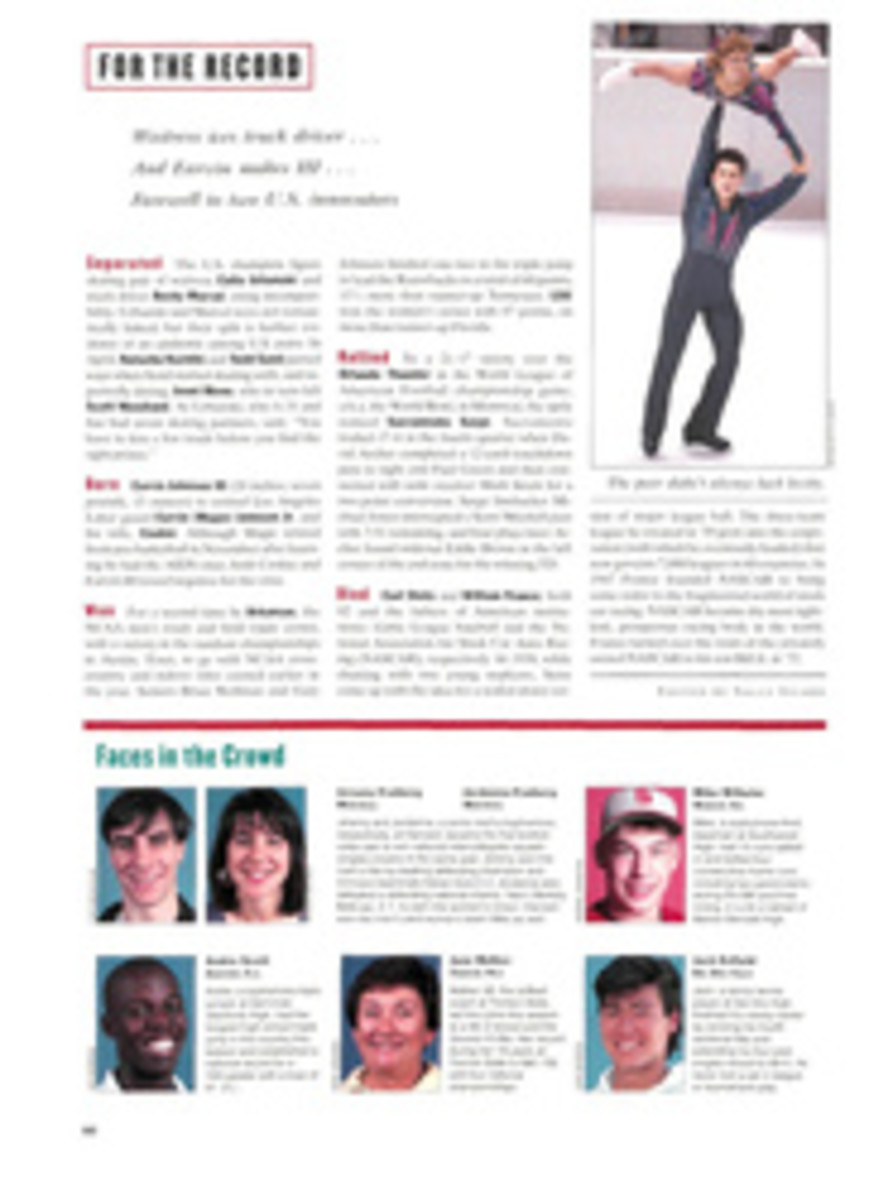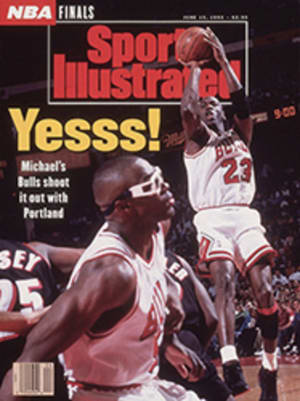
SCORECARD
The High Cost of Free Agency
It's a must-win situation for NFL players. Freeman McNeil v. National Football League, which is scheduled to go to trial in U.S. district court in Minneapolis on Monday, marks the third time the players have sued the league to obtain unfettered free agency. But never before have the players sacrificed so much to get to this point.
With the owners unwilling to give in to the players' demand for unrestricted free agency, there has been no collective bargaining agreement for almost five years. Without a contract the players could do nothing when management froze pension benefits, eliminated severance pay, added a week to the regular season and a round to the playoffs, implemented random drug testing, introduced a restricted free-agency system (Plan B) and raised the health insurance deductible from $200 to $1,400.
The players now want Plan B—in which a team protects 37 players after each season and sets the rest of its roster free—ruled illegal. They also want to collect damages for each of the protected players since 1990. The players hope that the owners will then be forced to negotiate a new contract that would include unrestricted free agency. Gene Upshaw, executive director of the NFLPA, says, "If we don't get free agency now, we're never going to get it."
There is a chance, albeit a slim one, of a pretrial settlement. When negotiations stalled last Thursday, the two sides were two years apart on a plan to allow unrestricted free agency (the owners said a player would have to play six years in the league before testing the open market; the players wanted four), millions of dollars apart on a possible salary cap and worlds apart on a wage scale for players in their first three years (the players want no part of such a scale). The likely scenario is that settlement talks will start again after a few weeks of court testimony, perhaps when the judge, David Doty, takes a two-week break in July to attend two conferences.
Paul Tagliabue, the NFL's principal attorney before he succeeded Pete Rozelle as commissioner in November 1989, has been positioning the owners for a settlement for two years. He removed several hardliners from the Management Council Executive Committee, the negotiating arm of the owners, and replaced them with such progressives as Denver Bronco owner Pat Bowlen and Buffalo Bills general manager Bill Polian. Tagliabue has also spent a lot of time on the phone with Jim Quinn, the players' chief negotiator and trial attorney, in talks that Tagliabue has described as "very serious."
So it's on to the courtroom, where the owners have lost several decisions but little ground. Former NFL player John Mackey won a historic antitrust judgment in 1972 and another former player, Marvin Powell, won significant rulings in '87. Another player, Yazoo Smith, got the NFL draft ruled illegal in '75. Even the USFL got a court to rule in '86 that the NFL was a monopoly. But the gains made in the Mackey and the Smith rulings were abandoned by the players during collective bargaining, and the USFL collected a whopping $3 in damages. The Powell decision was reversed by the eighth circuit court of appeals in November 1989—in the last case Tagliabue litigated for the NFL—when the court bought Tagliabue's argument that an individual could not sue for antitrust violations on a contract that had been bargained collectively.
After the Powell ruling, the NFLPA decertified as a union. Eight players, including New York Jet running back Freeman McNeil, filed suits against the NFL, claiming that Plan B, which was created after the Powell decision by Tagliabue to satisfy antitrust law, was, in fact, a violation of that law.
Assuming there is no settlement, the trial could go into September, and appeals could last another two to five years. "The public sees it as a battle of rich owners against rich players," says Bowlen. "You'd think we'd be smart enough to be able to sit down at a table and work it out."
Blast from the Past
Missing from most of Sunday's papers was a late National League score—110 years late.
The Troy Green Stockings defeated the Worcester Brown Stockings 2-0 at Knickerbacker Park in Troy, N.Y., last Saturday in the resumption of a series that ended with the conclusion of the 1882 season. That's when the two franchises, the weak sisters in the league, were asked to make way for two teams that would eventually become the New York Giants and the Philadelphia Phillies. Because Troy and Worcester left without a fuss, they were granted honorary memberships in the National League, memberships that have never been rescinded.
With that in mind, volunteers from the two cities, as well as from the Society for American Baseball Research, organized this spring classic, played by 1882 rules in the uniforms of the time with period equipment, what little there was of it. Only the catchers wore gloves, and they didn't have pads or masks. It also took seven balls to draw a walk, but the pitcher had to throw the ball to the level where the batter wanted it.
A crowd estimated at 3,000—considerably more than the handful of spectators who saw visiting Troy beat Worcester 10-7 in the teams' last meeting, on Sept. 29, 1882—watched the players arrive in horse-drawn carriages. As Troy city manager Steve Dworsky told the crowd, "If this many people had shown up 110 years ago, we could have been playing the New York Mets this afternoon."
The players, who came from over-30 leagues in both cities, put on an exciting game. The winning run came in the second inning of the five-inning game, thanks to a single by Ken Harrison of Troy on a 5-1 pitch. About the only anachronistic note came when Worcester pitcher John St. Pierre and first baseman Fran Henrickson exchanged a very un-1882-like high five after a nifty pickoff play.
After the game, players for both teams, which will meet again on June 20 in Worcester, signed autographs. "It felt like baseball," said Green Stocking first baseman Tom McGuire, a present-day insurance agent, "and it felt like 1882." Indeed, as McGuire let a little boy try to swing his 40-ounce hickory bat, McGuire could have been Hall of Famer Roger Connor, Troy's last first baseman.
—STEVE WULF
There's No Way to San Jose
Whither the San Francisco Giants? Last week, voters in San Jose rejected a proposal to build a $265 million to $300 million ballpark for the Giants on the northern periphery of their city (SI, June 1). It was the fourth time in six years—twice in San Francisco, once in neighboring Santa Clara County and now in San Jose, which is 50 miles south of San Francisco—that a Bay Area electorate has said no to a new ball yard, and the naysayers' margin of victory this time (55% to 45%) was the most convincing of all. "I'm very disappointed," said the Giants' owner Bob Lurie. "I really had hopes that we would win. I guess it's just the economic climate." Two days after the vote, former Giants catcher Mike Sadek, who's now an assistant director of community services for the team, tried to cheer up Lurie. "Don't worry," Sadek said. "I went oh for 4 all the time."
So what now? Lurie despises cold and blustery Candlestick Park and says his team won't stay there beyond the 1994 expiration of his lease. In fact, an escape clause permits him to pull up stakes as early as next year. Lurie, a San Francisco native who saved the Giants from moving to Toronto when he bought the team in 1976, probably will not take them out of town. He could, however, sell the Giants to auslanders. But the Bay Area, with six million people, is the fifth-largest television market in the country, and the National League would presumably be reluctant to leave the territory to the Oakland Athletics of the American League.
Saving the Giants would be a boon to San Francisco mayor Frank Jordan's embattled administration, and a local committee has already announced its readiness to proceed with a new ballpark downtown that would be privately financed. Groups in Sacramento and in Santa Clara County are expected to renew their efforts to lure the Giants, and they, too, say their bids will be privately financed.
No one is quite clear who will end up footing the bill if a stadium is built. What is clear is that taxpayers in the Bay Area are unwilling to put up the dough for a new playpen for a multimillionaire owner and his multimillionaire employees.
—RON FIMRITE
And the Pistons?
Chicago-area Chevrolet dealers have lucked out with the NBA playoffs. Their campaign slogan during the Eastern Conference finals was The Cavaliers Must Go, referring to Chevy's midsize car and the Chicago Bulls' opponents. Now the dealers are hoping to move some of their trucks with their slogan for the NBA Finals: It's Time to Blow Out the Blazers.
PHOTO
LAYNE KENNEDY
Doty will preside over the McNeil trial.
PHOTO
CHUCK SOLOMON
Even with 110 years to practice, Worcester (at bat) still couldn't beat Troy.
PHOTO
CHUCK SOLOMON
ILLUSTRATION
ARNOLD ROTH
Big Popper
When Mark McGwire took this mighty swing on our June 1 cover, the catcher behind him was Boston Red Sox rookie John Flaherty. After the issue came out Flaherty asked McGwire to autograph a copy. McGwire signed it and wrote, "To John. We both know this was a routine fly to Ellis [Burks, the Sox centerfielder]."
They Said It
Jim Rooker, Pittsburgh Pirate broadcaster, during a game in which the Pirates and San Francisco Giants played in period uniforms from 1939: "Congratulations to the 1939 Stanley Cup champions, the Boston Bruins. The New York Rangers look good for next year, but if they don't win it, they might not win it for the next 50 years."
Garth Iorg, manager of the Toronto Blue Jays' Double A club in Knoxville, Tenn., after infielder Rance Mulliniks, who used to platoon with Iorg at third base for Toronto, was sent to Knoxville: "He could manage against righties, and I could manage against lefties."

